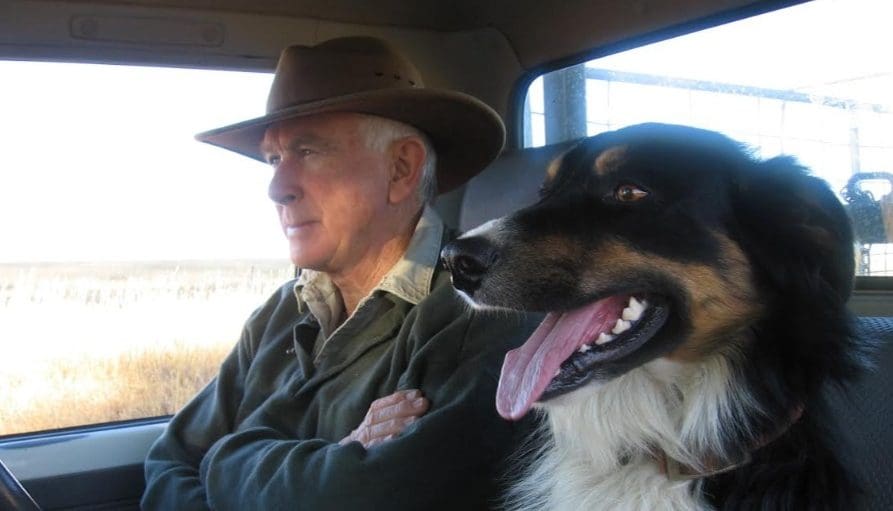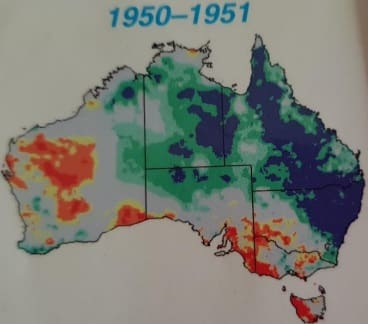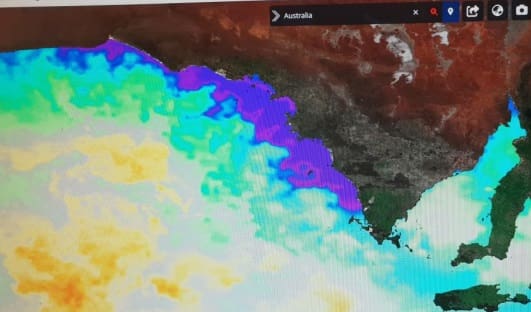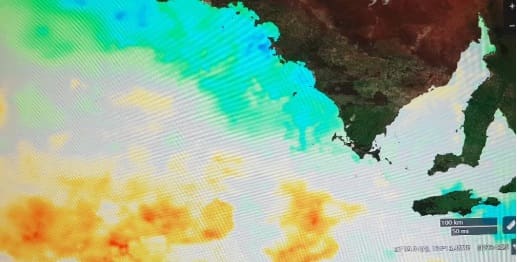
Western Victorian wool grower and lamb producer Peter Small and collie Jock.
Hopefully, in the Western District of Victoria we are now emerging from a very worrying period, particularly for livestock producers.
Whilst the experience is fresh in all our minds, I sought comments from a number of livestock producers as to what we have learnt from the last 12 months. This essay is an amalgam of their responses.
South-western Victoria is one of the most secure rainfall areas in Australia, but it is not immune from droughts. Sometimes it experiences the tail-end of national droughts and on rare occasions it experiences drought when the rest of Australia is having good seasons. 1950/51 was one such occasion.

There is much dithering by governments about the use of the “D” word. One thing we can all be sure, it will be unlikely that a drought will ever be declared in Australia again, or if it is, there is unlikely to be any government assistance to farmers.
The first thing we should have learnt from this current experience is that from here on, farmers are on their own. It is best to acknowledge this reality now.
In south-western Victoria, in my view, a drought is a failed spring, followed by a failed autumn. On this definition, this was definitely a drought, but the unusual summer rainfall events of late November, December and early January masked the seriousness of the failed spring. These summer rains, a welcome reprieve, lulled us into a false sense of security. Had these summer rains not arrived, the drought would have been far more severe and damaging.
Following seven exceptionally good years, and a good start to 2023, by June 2023 most country was extremely wet. In retrospect, diminishing rainfall from mid-July 2023 was a harbinger of what was to come, a failed spring, a failed autumn, a drought.
In my view the drought broke some 12 months after it commenced, around the middle of July 2024. Whilst the first fortnight of last August gave us all an awful fright, recent August rainfall, this year following above average rainfall for July, confirmed I think, that the drought for south-west Victoria is behind us – but time will tell.
In addition, institutions like the Department of Agriculture, the Pastoral and Veterinary Research Institute (PVI) and even the Victorian Farmers Federation (VFF) are no longer effective functioning entities as they were in the 2006, 1982 and 1967 droughts.
Nor do Western District farmers have an institution like the Birchip Cropping Group (BCG). The BCG is very adept in quickly marshalling resources to advise grain growers in a time of crisis. For example a few years ago, confronted by an extraordinarily wet harvest, BCG organised special schools for farmers to learn the best international practice to remove grain harvesters from bogs.
So the first thing I think we need to acknowledge is that farmers are now on their own. There is no value in waiting for help to arrive – we have to manage with our own resources.
During this dry time we have also had another foretaste of what is to come.
The last time this happened, to my knowledge, was with the ‘Menzies credit squeeze’ in 1961. Farmers and indeed the rest of the community, who assume they have plenty of equity on which to borrow, find that factors beyond the local banks’ control, result in additional bank credit being refused. Already there is evidence in the wider economy of banks pushing borrowers onto private equity funding.
This is a red light and an indication of what is to come.
Self-help:
An excellent example of self-help was early in this drought on 21 May, a group of farmers around Pigeon Ponds under the leadership of Tim Leeming organised a drought school at Nareen. This drought school provided excellent timely information to farmers.
Organising these events sooner rather than later is essential.
My attitude to droughts commenced in my childhood in the Victorian Mallee. My earliest memories are of the 1940s droughts, much worse in the north than in southwestern Victoria. Successful livestock producers in those days at Wycheproof for example, lived by the rule: ‘If it doesn’t rain by the 1st of August sell half your livestock and if doesn’t rain by the 1st of September sell the lot.’
Mallee farmers today are far more adroit at managing soil moisture and droughts than we are in the Western District.
Lessons learnt:
- Pre-planning for the inevitable drought must commence years in advance.
Provisions for droughts need to be in addition to normal seasonal supplementary feed requirements, and should include:
Reticulated farm stock water supply with water reserves to last at least two years with no run-off
Long-term and safe grain and hay or silage reserves. Grain in silos and hay in sheds has a high capital cost. Long term storage of silage or haylage in underground pits is inexpensive and almost 100 percent safe.
Standby containment paddocks, ready to go at short notice with water troughs and shade.
And/or Farm Management Deposits (FMD) deposited with your bank. FMDs ensure the farmer has access to immediate cash to buy feed and is not dependent on banks being able to create or extend credit. A rule of thumb objective could be to build up over time, $50,000 FMD per 1000 breeding ewes or equivalent livestock units.
Early spotting of an approaching drought is helpful, but often in the Western District, by the time a drought is evident, the drought is nearly over. But with high stocking rates, failure to act quickly can have serious consequences that can linger for years.
2. Actions:
First priority must be breeding stock.
Start feeding earlier rather than later. Ensure supplement contains adequate protein and energy to maintain body weight and support the foetus of pregnant ewes or cows. If you cannot calculate feed requirements of your livestock seek help from your vet or fellow farmer. Don’t be afraid to ask.
Once dry matter in paddocks approaches 1000 kilograms per hectare remove stock to containment areas. Ensure adequate access to minerals, particularly salt, lime and magnesium.
Pregnancy test three ways, singles, twins and triplets. Feed accordingly.
Regardless of rain and autumn break, get ewes into lambing paddocks at least two weeks before lambing.
Feed seven days of the week, around the same time each day. Ewes get used to the routine of the arrival of the feed truck and if freshly lambed, most ewes will stay with their lambs until the next day when the lambs are stronger. The lamb is next year’s income and every effort should be made to secure high lambing percentages.
Ian Holton, a retired long-range forecaster from Nairne in South Australia, emphasised to me years ago the importance of ocean temperatures south of Australia and how cold ocean temperatures south of Australia affected seasonal conditions in our region. This is evident particularly when seasonal conditions are good over the rest of the continent. 1950 was one such year.
Whilst no two years are ever the same, the rainfall map above shows a very similar pattern to this year. Here at Gritjurk in 1950, 387mm was recorded, a bit more than half our annual rainfall.

Note the intense cold ocean temperatures Great Australian Bight, May 2024.
Abnormally cold water south of the Great Australian Bight can effect frontal systems that normally bring moisture to South Australia and western Victoria. And below, cold waters breaking up July 2024 and warmer waters emerging to the south.

So let us hope that a bumper spring is ahead. Hopefully we have all now learnt how to prepare for difficult times, which are almost certain to return at some stage.
We can all learn from each other so any comments or additional suggestions on how to survive in difficult times always welcome.
The above article is printed with permission from Peter Small’s newsletter ‘From a window in Gritjurk.’
What Agriculture Victoria says about the ‘green drought’
An Agriculture Victoria spokesperson told Sheep Central in July the Victorian Government is closely monitoring and assessing the impacts of seasonal conditions, with a focus on south-west Victoria, and continues to tailor services accordingly to support farmers.
“Farmers are encouraged to seek out support through Agriculture Victoria’s tailored programs and services, the Rural Financial Counselling Service and Commonwealth Government programs.
“Agriculture Victoria does not use categories for different types of drought (e.g. ‘green drought’), but it does accept that a region can appear green due to the time of season on plant growth/appearance,” the spokesperson said.
“This is why Agriculture Victoria monitors a range of data sources such as soil moisture, rainfall, on-farm water storages, run off and stream flow when assessing seasonal conditions and impacts.”
The Victorian Government does not make drought declarations, in line with Australian Government policy. Instead Victoria’s Drought Preparedness and Response Framework guides informed and measured decisions about how best to support farmers, businesses and communities prepare for, manage and recover from the impacts of drought.
“The Victorian Government considers a range of seasonal, economic and social indicators to assess impacts and tailor assistance,” the spokesperson said.
“Victorian Government assistance is always available, even during non-drought periods.
“Services include the Rural Financial Counselling Service, Farm Business Resilience Program and Regional Drought Resilience Planning,” the spokesperson said.
“The Commonwealth Government also provides supports such as Farm Management Deposits Scheme, Farm Household Allowance, tax supports and low interest loans.
“The Victorian Government takes a flexible approach and considers a range of seasonal, economic and social information to assess impacts on industry and community to inform decisions on providing any additional supports.”
The Victorian Government, together with industry and partners, is providing information, tools and resources to help farmers manage dry seasonal conditions and ensure the nutritional requirements of livestock are met.
The Victorian and Commonwealth governments (through the Future Drought Fund) are committed to supporting farmers to prepare for drought and a changing climate.
The Farm Business Resilience program is helping Victorian farmers to prepare for drought, and the Regional Drought Resilience Planning program is supporting the resilience of Victoria’s regions.
Farmers facing financial difficulty can access free and confidential business planning support from the Rural Financial Counselling Service (RFCS). More information is available at agriculture.vic.gov.au/dryseasons

Excellent article by Peter Small. I think he left out ‘air is too dry’ in the bight to cause rain in the Western District.
Twice daily and daily rotations are a huge motivator of drought, as the rest and urine creates greener and more feed. I don’t agree with his lambing strategy, but it would be best for the overwhelming majority (99 percent) of farmers who have neither the paddocks nor the skills.
I strongly believe that the work done — excellent communication and leadership — by the Perennial Pasture Systems group — past present and future — far surpasses in effect the Birchip Cropping Group and Tim Leeming- for eg. recently evidenced by the 17th Annual conference Ararat attendance of 200 farmers on 21 September.
My advice is to watch the PPS by becoming an active member — like the Beatles it defies gravity.